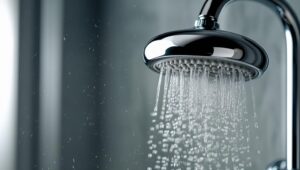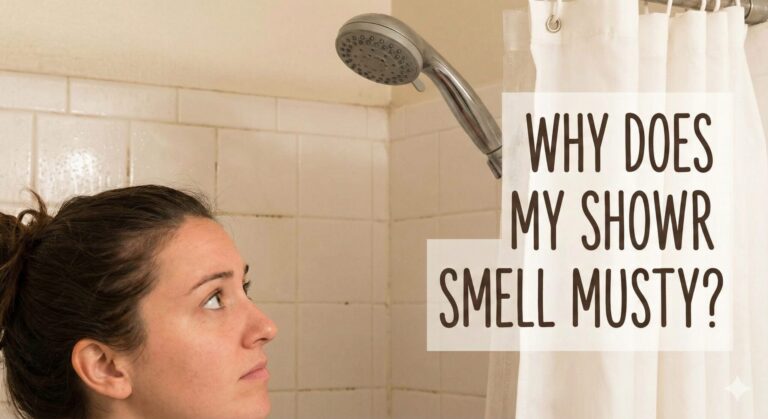Low Shower Pressure? A Step-by-Step Guide to Diagnosing and Fixing It Yourself
There are few things more disappointing than stepping into the shower, expecting a powerful, massaging spray, only to be met with a weak, lukewarm trickle. Low shower pressure is a common household problem, but the good news is that you can often fix it yourself without calling a plumber. The cause is usually a simple blockage that’s easy to clear.
This guide will walk you through the diagnostic process, starting with the most common and easiest fixes right at the shower head, then working our way back to more complex issues. Let’s restore your shower to its former glory!
Start Here: The #1 Culprit is a Clogged Shower Head
In over 90% of cases, the reason your shower pressure is low—especially if it has gotten worse over time—is because the shower head itself is clogged. Over months and years, mineral deposits (limescale from hard water) and tiny bits of sediment build up inside the head and block the small nozzles where the water sprays out.
Method 1: The No-Removal Vinegar Soak (The “Plastic Bag Trick”)
This is the easiest method and you can do it without any tools.
- Get a durable plastic bag, like a freezer or storage bag, that’s large enough to fit over your entire shower head.
- Fill the bag about halfway with plain white vinegar. If you have very hard water, you can use a dedicated CLR (Calcium, Lime, Rust) cleaner instead.
- Carefully place the bag over the shower head so the entire head is submerged in the vinegar.
- Secure the bag to the shower arm using a rubber band, zip tie, or string.
- Let it soak. For vinegar, let it sit for at least a few hours, or ideally, overnight. For CLR, follow the package directions (usually much shorter).
- Remove the bag and turn on the shower at full blast for a minute to flush out all the loosened debris. Use an old toothbrush to scrub any remaining deposits off the nozzles.
Method 2: The Deep Clean (Requires Removal)
If the bag trick doesn’t fully work, or you want a more thorough cleaning, removing the head is the next step.
- Unscrew the shower head from the shower arm. Usually, this can be done by hand. If it’s tight, use a wrench or adjustable pliers. **Pro Tip:** Wrap the connector with a rag or duct tape before using a wrench to avoid scratching the finish.
- Look inside the connector. You’ll likely see a small mesh screen. This is a filter designed to catch sediment. Gently pry it out with a paperclip and rinse it thoroughly. This screen is often the main cause of a clog!
- Submerge the entire head in a bucket or bowl of vinegar or CLR solution and let it soak.
- After soaking, use a small brush or a paperclip to poke debris out of each individual spray nozzle.
- Rinse everything thoroughly, put the filter screen back in, and screw the shower head back onto the arm. Hand-tighten, then give it a final quarter-turn with a wrench if needed.
CLR Pro Calcium, Lime & Rust Remover
When vinegar isn’t strong enough for seriously hard water, this is the solution. It’s incredibly effective at dissolving mineral buildup fast. A must-have for any home with hard water issues. It works much faster than vinegar for tough clogs.
Check Price on Amazon
Is Your *New* Shower Head Low Pressure? Check the Flow Restrictor
What if you just installed a brand-new shower head and the pressure is terrible? The problem is almost certainly the **flow restrictor**. To comply with U.S. water conservation standards, all modern shower heads are manufactured with a small plastic disc inside that limits the water flow to a maximum of 2.5 gallons per minute (GPM).
While great for saving water, it can make the pressure feel weak if your home’s overall pressure is already on the low side. You can often remove this part.
- Unscrew the new shower head.
- Look inside the part that connects to the pipe. You’ll see the mesh filter screen, and behind or as part of it, a plastic disc, often brightly colored (red, green, or pink). This is the flow restrictor.
- Using a paperclip or needle-nose pliers, you can usually pry this plastic disc out. It might take a bit of wiggling.
- Reinstall the shower head. The difference will be immediate.
Disclaimer: Removing the flow restrictor will significantly increase your water usage and your water bill. Before doing this, check your local city and state regulations, as it may be prohibited in some drought-prone areas.
When Cleaning Isn’t Enough: Deeper Issues
If you’ve cleaned the head and checked for a flow restrictor, but the pressure is still low, it’s time to do some quick diagnostics to see if the problem lies deeper in your plumbing.
Critical Diagnostic Step: Turn on other faucets in your house, like the bathroom sink and kitchen sink. Is the pressure low everywhere, or ONLY in the shower?
- If pressure is low **everywhere**, the problem isn’t your shower. It could be that your home’s main shutoff valve isn’t fully open, or there could be an issue with the water supply from your city.
- If pressure is ONLY low in the shower, the problem is isolated to that specific fixture.
Could it be the Diverter Valve?
The diverter is the knob or lever you pull to switch the water flow from the tub spout up to the shower head. These can wear out over time. The classic symptom of a failing diverter is when you pull it up for the shower, but a significant amount of water continues to pour out of the tub spout. That “leaking” water is pressure that isn’t making it to your shower head.
The Ultimate Solution: Upgrade to a High-Pressure Shower Head
Sometimes, an old shower head is just poorly designed. If your cleaning efforts don’t yield results, the easiest and most satisfying solution is often to simply upgrade. “High-pressure” shower heads don’t magically create more pressure from your pipes; they use clever engineering (air induction, smaller nozzles, compression chambers) to make the water feel much, much stronger.
SparkPod High Pressure Rain Shower Head
This is one of the most popular and highly-rated models for a reason. It delivers a fantastic, powerful rain-style shower even in homes with low pressure. It’s incredibly easy to install and comes with a removable flow restrictor for maximum power.
Check Price on Amazon
HOPOPRO High Pressure Handheld Shower Head Set
If you prefer the flexibility of a handheld sprayer, this model is a great choice. It offers multiple spray settings, from a powerful massage jet to a gentle mist, and is specifically designed to maximize pressure. Great for rinsing hair, cleaning the shower, or bathing pets.
Check Price on Amazon
Votmell Premium Teflon Thread Seal Tape
Don’t forget the most important accessory! Before you screw on your new shower head, wrap the threads on the shower arm with 3-4 layers of this tape. It creates a perfect, leak-free seal. A single roll will last you for years of plumbing projects.
Check Price on Amazon
When to Call a Professional Plumber
While many issues are DIY-friendly, some problems require a pro. Call a plumber if:
- You’ve tried all the steps above and the pressure is still low.
- The water pressure is low throughout your entire house.
- You have a faulty diverter or mixing valve and aren’t comfortable replacing it yourself.
- You suspect a leak inside your walls (e.g., you see water stains).








